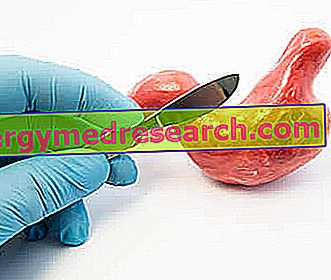Premise
Stomach cancer, mainly represented by gastric adenocarcinoma, is a neoplasm that is difficult to treat.

Just to give an idea of how difficult the early diagnosis of gastric neoplasms is, consider that, in an advanced country like the United States, doctors can identify an early stomach tumor only in one patient every 5 (so only 20% of diagnoses are early).
Therapy
Stomach cancer therapy is strictly dependent on some factors, which are: the site of the tumor mass, the staging of the malignant neoplasm (tumor size, presence of metastases, etc.) and the patient's general health (age, presence of other pathologies etc.).
Currently, the therapeutic options available to an individual with a gastric neoplasm are:
- Surgical removal of the tumor mass;
- Radiotherapy;
- Chemotherapy;
- The so-called "targeted therapy".
Summary of stages of a stomach tumor |
| Stage 0 : the tumor mass is limited to the most superficial cellular sheet of the mucous membrane of the stomach. |
Stage I : the tumor mass can involve one or more of the different cellular sheets that make up the mucous membrane of the stomach. A minimum presence of metastasis in up to 2 neighboring lymph nodes is possible. |
Stage II : the tumor mass has penetrated beyond the mucous membrane, therefore it affects the underlying tonache. Possible presence of metastases in up to 6 neighboring lymph nodes. |
Stage III : the tumor mass has expanded to the point of having invaded one or more adjacent organs and the neighboring lymph nodes. Alternatively, it may not have affected the adjacent organs, but have spread metastases in the lymphatic system and contaminated the lymph nodes distant from the site of tumor origin. |
Stage IV : the tumor mass has invaded the neighboring organs and has spread metastasis in organs and lymph nodes distant from the place of origin. |
SURGERY
Surgical removal of a stomach tumor is a delicate operation, which is generally feasible only at the first three stages of the neoplasm (0, I and II) and only if the tumor mass occupies a position that can be reached by the surgeon's hands.
There are various types of surgery; in the list below, the reader will find a brief description of the various types of surgery, including indications (ie on which specific occasions the surgeons adopt a certain type of intervention).
- Endoscopic resection of the mucosa : it is not really a surgery; nevertheless, doctors still include it among the surgical practices for the treatment of stomach cancer.
It consists in the removal of the tumor mass and of the portion of the gastric mucosa involved through an endoscope (ie the same instrument for diagnostic endoscopy procedures), on which a special micro-scalpel is mounted.
Indications: endoscopic mucosal resection is feasible only when the stomach tumor is at the very first stage (stage 0) and affects the most superficial portion of the gastric mucosa. In fact, its realization is very rare, as the identification of gastric neoplasms at the beginning is very uncommon.
- Partial gastrectomy : it is the surgical removal of the lower part of the stomach, performed by laparoscopic technique (laparoscopy) or laparotomy (laparotomy).
This procedure always involves the surgical union of what remains of the stomach with the small intestine, to restore the continuity of the digestive tract.
Indications: partial gastrectomy is indicated for the elimination of gastric tumors still confined to the mucous membrane of the stomach (usually stage I) and located in the lower portion of the stomach (the so-called "stomach antrum").
- Total gastrectomy : it is the surgical removal of the entire stomach, performed in laparoscopy or laparotomy.
Similar to the partial gastrectomy, this delicate operation always involves the surgical union of the esophagus to the small intestine, to restore the continuity of the digestive tract.
Indications: total gastrectomy is indicated for the elimination of stomach tumors that have also invaded the other cellular stomach tissues (usually stage II) and also some perigastric lymph nodes.
Before concluding this section dedicated to the surgical treatment of stomach cancer, it is important to clarify three aspects, which for some might be taken for granted:
- The possible contamination by the gastric tumor of a neighboring organ makes it necessary to remove not only the sick stomach, but also part of the adjacent organ affected by the neoplasm. In these situations, there is also talk of enlarged gastrectomy;
- During the gastrectomy for stomach cancer that has contaminated the perigastric lymph nodes, removal of these lymph nodes is also expected;
- Surgical removal of a stage III and IV stomach tumor is an intervention of little use for therapeutic purposes, however doctors may still practice it as a palliative care.
RADIOTHERAPY
Radiation therapy consists of exposing the tumor mass to a certain dose of high-energy ionizing radiation (X-rays), with the aim of destroying the neoplastic cells.
In the case of stomach cancer, radiotherapy can represent:
- A form of post-surgical treatment . In these situations, there is also talk of adjuvant radiotherapy . The purpose of adjuvant radiotherapy is to destroy the tumor cells that the surgery has not removed with X-rays.
Indications: stage I stomach tumors.
- A form of pre-surgical treatment . In such circumstances, radiotherapy is called neoadjuvant radiotherapy . The purpose of neoadjuvant radiotherapy is to reduce the size of the tumor mass, to facilitate the surgical removal that will take place later.
Indications: stage II stomach tumors.
- A form of treatment combined with chemotherapy and an alternative to surgery . The combination of radiotherapy and chemotherapy is called chemoradiotherapy .
Indications: as a causal therapy, in stage I and II tumors that cannot be operated surgically; as symptomatic therapy (or palliative care), in stage III or IV stomach tumors.
Stomach tumor and, in short, stage by stage therapeutic implications. | |
| Stadium | Therapy adopted |
Stage 0 | Mucosal endoscopy resection. Alternatively, gastrectomy (partial or total removal of the stomach) without chemotherapy or radiotherapy. |
Stage I | Gastrectomy, almost always followed by chemotherapy and / or radiotherapy. Alternatively, if surgery is not viable, only chemoradiotherapy (ie chemotherapy associated with radiotherapy). |
Stage II | Gastrectomy preceded by chemotherapy or radiotherapy. Alternatively, if surgery is not practicable, chemoradiotherapy. |
Stage III | It may be impossible to intervene. However, if it is possible, the therapy consists of a gastrectomy preceded by chemotherapy and followed by radiotherapy. The treatment acts as a palliative care. |
Stage IV | It is generally ineffective and sometimes any form of treatment is impossible. When possible, a possible therapy only serves to temporarily improve the symptomatology (palliative care). |
CHEMOTHERAPY
Chemotherapy consists of the administration, intravenously or orally, of drugs capable of killing rapidly growing cells, including cancer cells.
Depending on the characteristics of stomach cancer, the attending physician can decide whether to opt for:
- Post-surgical chemotherapy or adjuvant chemotherapy . The aim is the same as for adjuvant radiotherapy: to destroy the cancer cells that the surgeon was unable to remove.
Indications: stage I stomach tumors.
- Pre-surgical chemotherapy or neoadjuvant chemotherapy . The objective is the same as that of neoadjuvant radiotherapy: reducing the size of the tumor mass, to facilitate subsequent surgical removal.
Indications: stage II stomach tumors.
- Chemotherapy combined with radiotherapy or chemoradiotherapy . It is the form of chemotherapy that was mentioned in the previous sub-chapter, dedicated to radiotherapy; therefore, it is applied in place of surgery, when the latter is impractical.
Indications: as a causal therapy, in stage I and II tumors that cannot be operated surgically; as symptomatic therapy (palliative care), in stage III and IV stomach tumors.
Possible chemotherapy drugs used in the presence of stomach cancer:
- Oxaliplatin
- Fluorouracil
- Capecitabine
- Cisplatin
- carboplatin
- Docetaxel
- Irinotecan
- Epirubicin
TARGETED THERAPY
The " targeted therapy " is a treatment based on particular drugs, which specifically counteract everything that promotes the growth and development of cancer cells. It is different from chemotherapy, because it is more selective : chemotherapeutic drugs, in fact, attack all rapidly growing cells, including neoplastic cells (but not only).
The drugs for targeted therapy of stomach cancer include:
- trastuzumab;
- Ramucirumab;
- Imatinib;
- Sunitinib;
- Regorafenib.
To learn more, read: Stomach Cancer Treatment Medicines »
Food tips
As far as the dietary regime is concerned, patients with stomach cancer must avoid or limit to a maximum degree foods containing an excess of salt (pickled foods, sliced meats, etc.), foods rich in preservatives (because they contain nitrates), fried and fatty foods, alcoholic beverages and smoked foods; while, they should prefer a diet rich in fresh fruit and vegetables with a high content of vitamin A and C, whole-grain cereals and cold-pressed vegetable oils.
Prognosis
Stomach cancer generally has a poor prognosis in most patients and this is due to the extreme difficulty of its early diagnosis. As mentioned at the beginning of the article, the problem of early diagnosis is linked to the absence of symptoms during the initial phase of the neoplasm.
Regarding the survival rate of stomach cancer 5 years after diagnosis, statistical studies say that:
- When gastric cancer is detected at the beginning of the disease (minority of cases), 67% of patients are still alive after 5 years;
- When gastric cancer is diagnosed in a phase in which it has contaminated only the neighboring organs and lymph nodes, 31% of patients are still alive after 5 years;
- When gastric cancer is detected in an extremely advanced metastatic phase (most cases), only 5% of patients are still alive after 5 years.
From these numerical data it can be inferred that, if a valid test existed for an early diagnosis of stomach cancer, the prognosis would be better in a decidedly higher number of patients, compared to the present moment.
Prevention
As long as the triggering causes are not clear, preventing gastric tumors with absolute certainty is impossible.
CAN YOU DO SOMETHING?
Do not smoke (or quit smoking if you are a smoker), avoid excessive salting of foods, avoid foods preserved in salt, exercise, adopt a healthy lifestyle that includes a diet rich in fruits and vegetables, not abusing alcoholic beverages and favoring whole grains are the main recommendations, provided by doctors, to reduce the risk of getting stomach cancer.



